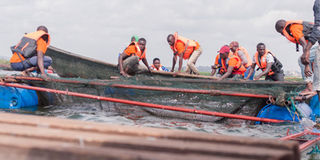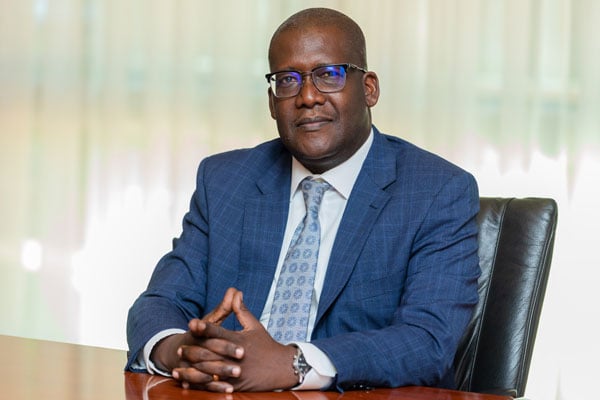14 youths profit from fish exports

Youth harvest fish from cages in Lake Victoria, Jinja. Prior to production, the youth are assured of market. Below: Part of the fish harvested is poured into a harvest basin. PHOTOS BY CHRISTINE KASEMIIRE
What you need to know:
- A team of 14 members of Masese youth fish farmers earn a living through farming fish in four cages, with a capacity of 5,000 each. Christine Kasemiire explores how they earn money along the fish value chain and export part of their produce.
David Olyabo is just a few years over 20. He is part of the 4,979 youth between 18 years to 30 that Uganda Bureau of Statistics (UBOS) said were working in Masese Division, Jinja District.
He is the chairman of 13 youth in the Masese youth fish farmers group.
The male dominated group with only one lady wakes up early in the morning to clear water hyacinths blown by the waves to the calm island where their boats dock.
The group of young people met each other when a non- government organisation, Swisscontact in partnership with Master Card Foundation through their programme dubbed U-learn, teamed up to fight unemployment in East Africa. They called out to all interested youth to sign up for skills equipment as well as basic capital.
Through a number of applications, many youth were given community-based training, financial literacy skills and market was promised to all dedicated and productive teams.
“We link young people with ready market and discuss about opportunities. If they agree, we support them with life skills, social skills,” Ms Tania Haidara, the country director Swisscontact said.
Different teams were created randomly to which many of the unserious dropped out. Masese youth fish farmers has stood the test of time, thanks to Mr Olyabo, the glue that binds all the youth.
A role he has executed with diplomacy, respect as well as job specialisation and record keeping for accountability.
Masese youth earn a living through farming fish in four cages, with a capacity of 5,000 each. Through the whole exercise, the boys jointly clear the water, clean the boats, harvest the fish from the cages while the girl does all the record keeping.
“We are 13 boys working with one girl because most of them find these jobs hectic. She records everything that we do,” he said.
Youth have always been criticised for seeking quick money from their jobs. Bur this is not the case with the Masese youth. They have to wait nine months until they can harvest the 20,000 fingerlings they put in the water.
Money
According to Uganda Bureau of Statistics, in 2016, 468m tonnes of fish was caught in Uganda water bodies.
Masese youth, since 2017, have so far seen two harvests, earning them more than Shs32m from 3.6 tonnes of fish.
How they earn
Aside from the skills attained from Swisscontact, the earnings from the harvest are paid directly to the youths’ accounts, enabling them save and plan on achieving their individual goals.
“We sign a Memorandum of Understanding about the prices. We make it even before we start harvesting. So by the time we harvest, we already know how much they are paying and in a week, the cooperative banks the money in our accounts,” Mr Olyabo said.
Challenges
However, the waters can spring up their own shortcomings. When the sea is rough, the youth whose main weapon through the waves and tides is a pedal boat, have no option but to leave the fish to starve because the waters are impassable.
Feeds which are a main catalyzer for the fish’s growth are also fake. The youth, who spend huge amounts of money on the feeds to ensure the fish is healthy, are sometimes left distressed after purchasing fake feeds.
“Fake feeds cannot let us grow the fish until our estimated period. So we end up lengthening the production cycle of the fish and yet our costs are still going up,” he said.
The aging cycle of fish, he said, is determined by the feeds. In essence, there are feeds that will hasten the growth of fish in six months, contrary to that of nine months, which the youth use because of the high cost of the former.
Future
Having inspired many in Masese, 15 more youth are expected to join Mr Olyabo’s group and get employed through the fish farming project. The project is expected to grow further once about 10,000 fish are added to their cages after every three months to increase in the number of fish produced.
Employment
Just like any situation, an economic activity breeds development to the surrounding environment. The Masese youth fish farmers’ project employs other people. The entire process extends to more than 15 people in addition of the youth to reach its completion.
Women from surrounding areas sit with their buckets at the mouth of the lake waiting on the young men to bring fish for packing.
MARKET
Prior to production, the youth are assured of market because part of the commitments made by Swiss Contacts was to look for market for the youth as long as they are productive. As a result, the youth were linked to the Masese Cage Fish Farmers Cooperative, such that after the nine months elapse, the youth already have their market.
“We are 70 members with 350 cages. In a year, we export between 50 and 80 tonnes of fish to Rwanda and Kenya,” the chairman of the cooperative, Mr Majid Magumba, said.




